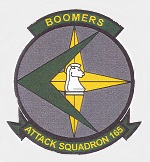Hobby Master HA2913 USN Douglas A-1H Skyraider Attack Aircraft - "Puff The Magic Dragon", VA-165 "Boomers" (1:72 Scale)
"My program is unique in the military service in this respect: You know the expression 'from the womb to the tomb'; my organization is responsible for initiating the idea for a project; for doing the research, and the development; designing and building the equipment that goes into the ships; for the operations of the ship; for the selection of the officers and men who man the ship; for their education and training. In short, I am responsible for the ship throughout its life from the very beginning to the very end."
- Admiral Hyman Rickover, "Father of the Nuclear Navy"
 The Douglas A-1 (formerly AD) Skyraider was an American single-seat attack bomber of the 1950s, 1960s and early 1970s. A propeller-driven anachronism in the jet age, the Skyraider had a remarkably long and successful career well into the space age, and inspired a straight-winged, slow-flying, jet-powered successor which is still in front line service today, the A-10 Thunderbolt II (Warthog).
The Douglas A-1 (formerly AD) Skyraider was an American single-seat attack bomber of the 1950s, 1960s and early 1970s. A propeller-driven anachronism in the jet age, the Skyraider had a remarkably long and successful career well into the space age, and inspired a straight-winged, slow-flying, jet-powered successor which is still in front line service today, the A-10 Thunderbolt II (Warthog).
It was operated by the United States Navy (USN), the U.S. Marine Corps (USMC) and the United States Air Force (USAF), and also saw service with the British Royal Navy, the French Air Force, and the Air Force of the Republic of Vietnam (VNAF), among others.
The piston-engined A-1 was designed during World War II to meet requirements for a carrier-based, single-seat, long-range, high performance dive/torpedo bomber, and was a follow-on to earlier dive bombers and torpedo bombers used by the Navy such as the Helldiver and Avenger. Designed by Ed Heinemann of the Douglas Aircraft Company, prototypes were ordered on 6 July 1944 as the XBT2D-1. The XBT2D-1 made its first flight on 18 March 1945 and in April 1945, the USN began evaluation of the aircraft at the Naval Air Test Center (NATC). In December 1946, after a designation change to AD-1, delivery of the first production aircraft to a fleet squadron was made to VA-19A.
The AD-1 was built at Douglas' El Segundo plant in Southern California. In his memoir The Lonely Sky, test pilot Bill Bridgeman describes the routine yet sometimes hazardous work of certifying AD-1s fresh off the assembly line (quoting a production rate of two aircraft per day) for delivery to the U.S. Navy in 1949 and 1950.
The low-wing monoplane design started with a Wright R-3350 radial engine, later upgraded several times. Its distinctive feature was large straight wings with seven hard points apiece. These gave the aircraft excellent low-speed maneuverability, and enabled it to carry a tremendous amount of ordnance over a considerable combat radius and loiter time for its size, comparable to much heavier subsonic or supersonic jets. The aircraft is optimized for the ground-attack mission and is armored against ground fire in key locations. This was unlike faster fighters adapted to carry bombs such as the F4U Corsair or P-51 Mustang, which would be retired by U.S. forces long before the 1960s.
Navy A-1s were initially painted dark blue, but during the 1950s following the Korean War, the color scheme was changed to gray and white. Initially using the gray and white Navy pattern, by 1967 the USAF began to paint its Skyraiders in a camouflaged pattern using two shades of green, and one of tan.
Used by the USN over Korea and Vietnam, the A-1 was a primary close air support aircraft for the USAF and VNAF during the Vietnam War. The A-1 was famous for being able to take hits and keep flying. Battle damage images from the Korean and Vietnam wars speak for themselves. There was added armor plating around the cockpit area for added pilot protection. It was replaced in the early 1970s by the A-4 Skyhawk as the Navy's primary light attack plane.
Pictured here is a 1:72 scale replica of a US Navy Douglas A-1H Skyraider attack aircraft that was nicknamed "Puff The Magic Dragon", and attached to VA-165 "Boomers".
Sold Out!
Dimensions:
Wingspan: 8-1/4-inches
Length: 7-inches
Release Date: September 2017
 Historical Account: "Boomers" - VA-165, nicknamed the Boomers, was a long-lived Attack Squadron of the U.S. Navy. It was established on September 1st, 1960, and disestablished 35 years later on September 30th, 1996. The squadron operated in the region of Vietnam, Laos, and Korea during the 1960s and early 1970s. VA-165 transferred to the Persian Gulf after the 1973 Yom Kippur War, and also served near the Philippines during the late 1970s. During the 1980s, VA-165 was moved from the Middle East to Central America, particularly Nicaragua, back to Iran in the Middle East, off to South Korea, and then to the Middle East again for Kuwait. During the 1990s, the squadron worked in the United States, the Middle East, and Taiwan.
Historical Account: "Boomers" - VA-165, nicknamed the Boomers, was a long-lived Attack Squadron of the U.S. Navy. It was established on September 1st, 1960, and disestablished 35 years later on September 30th, 1996. The squadron operated in the region of Vietnam, Laos, and Korea during the 1960s and early 1970s. VA-165 transferred to the Persian Gulf after the 1973 Yom Kippur War, and also served near the Philippines during the late 1970s. During the 1980s, VA-165 was moved from the Middle East to Central America, particularly Nicaragua, back to Iran in the Middle East, off to South Korea, and then to the Middle East again for Kuwait. During the 1990s, the squadron worked in the United States, the Middle East, and Taiwan.


